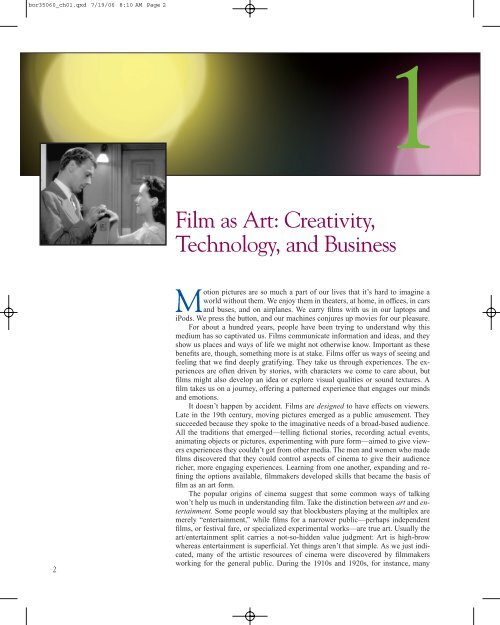FILM ART AND FILMMAKING
FILM ART AND FILMMAKING
FILM ART AND FILMMAKING
Create successful ePaper yourself
Turn your PDF publications into a flip-book with our unique Google optimized e-Paper software.
or35060_ch01.qxd 7/19/06 8:10 AM Page 2<br />
2<br />
Film as Art: Creativity,<br />
Technology, and Business<br />
1<br />
Motion pictures are so much a part of our lives that it’s hard to imagine a<br />
world without them. We enjoy them in theaters, at home, in offices, in cars<br />
and buses, and on airplanes. We carry films with us in our laptops and<br />
iPods. We press the button, and our machines conjures up movies for our pleasure.<br />
For about a hundred years, people have been trying to understand why this<br />
medium has so captivated us. Films communicate information and ideas, and they<br />
show us places and ways of life we might not otherwise know. Important as these<br />
benefits are, though, something more is at stake. Films offer us ways of seeing and<br />
feeling that we find deeply gratifying. They take us through experiences. The experiences<br />
are often driven by stories, with characters we come to care about, but<br />
films might also develop an idea or explore visual qualities or sound textures. A<br />
film takes us on a journey, offering a patterned experience that engages our minds<br />
and emotions.<br />
It doesn’t happen by accident. Films are designed to have effects on viewers.<br />
Late in the 19th century, moving pictures emerged as a public amusement. They<br />
succeeded because they spoke to the imaginative needs of a broad-based audience.<br />
All the traditions that emerged—telling fictional stories, recording actual events,<br />
animating objects or pictures, experimenting with pure form—aimed to give viewers<br />
experiences they couldn’t get from other media. The men and women who made<br />
films discovered that they could control aspects of cinema to give their audience<br />
richer, more engaging experiences. Learning from one another, expanding and refining<br />
the options available, filmmakers developed skills that became the basis of<br />
film as an art form.<br />
The popular origins of cinema suggest that some common ways of talking<br />
won’t help us much in understanding film. Take the distinction between art and entertainment.<br />
Some people would say that blockbusters playing at the multiplex are<br />
merely “entertainment,” while films for a narrower public—perhaps independent<br />
films, or festival fare, or specialized experimental works—are true art. Usually the<br />
art/entertainment split carries a not-so-hidden value judgment: Art is high-brow<br />
whereas entertainment is superficial. Yet things aren’t that simple. As we just indicated,<br />
many of the artistic resources of cinema were discovered by filmmakers<br />
working for the general public. During the 1910s and 1920s, for instance, many

















